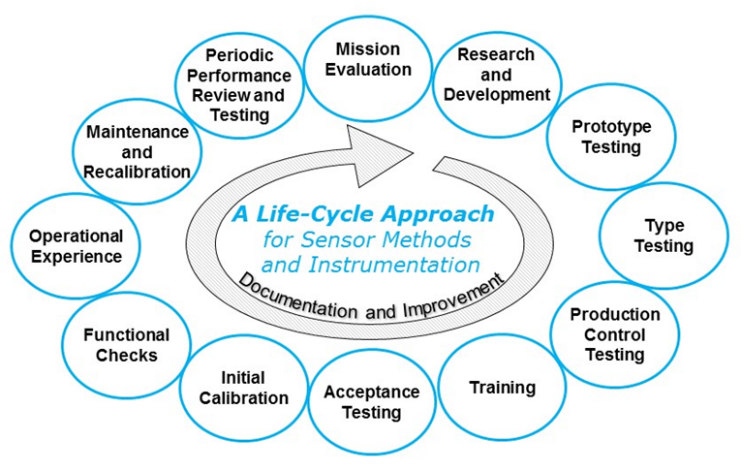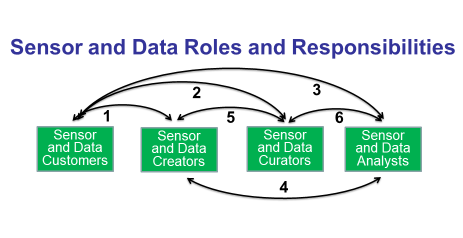Right Sensors Used Right: A Life-cycle Approach for Real-time Monitors and Direct Reading Methodologies and Data. A Call to Action for Customers, Creators, Curators, and Analysts
Posted on byThe Right Sensors Used Right Approach
Right Sensors Used Right is an approach of the NIOSH Center for Direct Reading and Sensor Technologies. The objective is to promote the competent development, adoption, and interpretation of real-time monitors and direct-reading methodologies. It also aims to improve the interpretation of the data for taking action in work environments. Encouraging involved individuals to consider the capabilities and limitations of a technology can improve the ability to address modern measurement challenges.
The Right Sensors Used Right approach has its roots in the concept that every real-time monitor or direct-reading methodology has its own unique way of fitting into a generic life-cycle (Figure 1). The life-cycle for the development and application of direct-reading methodologies and sensor technologies shows key steps that are taken to ensure the relevance and reliability of measurements to protect workers. The cycle begins with identifying what needs to be measured, under what conditions it needs to be measured, and how well it needs to be measured. The life-cycle concept is well described in several publications1-3 and presented in the AIHA Synergist article on Turning Numbers into Knowledge being used to meet all emerging sensor needs. 4
Each step of the life cycle is essential for the successful development of a new technology, for its adoption, and for transforming the data generated by the methodology into meaningful and useful information for occupational safety and health. Following the life-cycle process helps to ensure that the technology will work as intended under realistic conditions. For each technology, the life-cycle is continuingly active while improvements and adjustments are applied. Documenting the history of each life-cycle is essential.

The relative importance of the individual steps depends on the unique requirements of a given mission and specific real-time monitor or direct-reading methodology. Nevertheless, every step has an effect on the capabilities and limitations of each technology.
Roles and Responsibilities of Sensor and Data Customers, Creators, Curators, and Analysts in the Life Cycle
Several individuals are engaged in the life cycle and they share roles and responsibilities. As illustrated in Figure 2, these individuals fit across four categories: customers, creators, curators, and analysts. This division was first proposed in relation to sensor methods and data in nanotechnology.5 In some instances, the same individuals may perform multiple roles. It may also be that many individuals must interact throughout the lifecycle process and their roles often extend over significant distances, organizations, and times, meaning that effective communication across the groups is essential. As the arrows in Figure 2 illustrate, there are six possible inter-categories interactions and they must work effectively in both directions.

From the perspective of the Right Sensors Used Right approach:
Customers of real-time monitors and direct-reading methodologies and the resulting data include health and safety professionals, industrial/occupational hygienists, and anyone needing actionable information from the adoption of sensor technologies. Customers have a significant role in expressing the details of what sensor data will be needed and how it will be used. In some cases, customers have an opportunity to partner with a sensor developer to guide the development process. However, customers generally do not see new technologies until it is time for selection and implementation. From that moment on, customers are actively involved and responsible for the quality of the data generated by the technology.
Creators are individuals involved in the design and development of a real-time monitor or direct-reading methodology. The sensor creators will develop a technology from scratch or they will repurpose and adapt an existing technology for a new application. Many different creators might be involved in one single life cycle: from an idea to a proof of concept, to a prototype, to production. The creators are mostly involved and responsible for the initial steps of the life cycle and typically include researchers at Universities, R&D teams at private companies, or developers in federal agencies. Once a monitor or method has been adopted, the users of the technology become the data creators.
Curators serve the critical role of maintaining and assuring the quality of the technology and data generated. The quality of the real-time monitor and direct-reading methodology and of the data generated by the technology is one of the most important factors related to use for health and safety. Curators can be institutions, associations, and manufacturers. The effects of the actions of curators can be present in every step of the life cycle from the production to the acceptance testing, to periodic performance review.
Analysts “turn the numbers into knowledge” to enable the real-time monitor or direct-reading methodology data to be translated into information for decision making in terms of health and safety. This process can be quite simple and straightforward or more complex. In both cases, the process is under the responsibility of one or more analysts. The analyst needs to be aware of the capabilities and limitation of the technology to generate data at the quality level assured by the curator in order to meet the need of the customer.
Sensor and data Customers, Creators, Curators, and Analysts should all be involved in adopting a Right Sensors Used Right approach in the identification and usage of real-time monitors and direct-reading methodologies. The involvement entails additional responsibilities too. In the case of traditional analytical techniques, the responsibilities are shared also with analytical laboratories. For the nature of the real-time monitors and direct-reading methodologies, analytical laboratories are almost absent in their life cycle.
An Opportunity for Input and Discussion
Some aspects of the Right Sensors Used Right approach that warrant input and discussion among the occupational safety and health community are:
- How can trade-offs related to the different cost and performance characteristics of different methods be made to get the most relevant, reliable, and actionable results possible? Not every commercially available product is equal when used as a real-time monitor and direct-reading methodology for a specific hazard or exposure. Recognizing the need of the customer for when, where, how often, and of what quality of data are needed should lead to the identification and selection of the right product once the capabilities and limitations are known. In some cases it may be better to use many, lower cost/accuracy sensors than a few excellent sensors.
- How can useful and accessible sensor performance data be created and curated? Guidelines and protocols to assess the performance of technologies should be developed. New products become available all the time for the same hazard. How the new technology can fit the existing or new needs of customers needs to be assessed.
- Do the current steps in the Right Sensors Used Right life cycle enable the proper implementation of a technology from a technical perspective? In order to fulfill the need, it is essential to assure the quality of the data. This data quality is not solely the responsibility of customer. Creators should consider the field implementation in the design of the product and curators and analysts should be involved in this step as well.
- What are the ethical challenges related to the use of sensors and sensor data, and how can those challenges be met? The use of real-time wearable monitors brings new concerns on the implementation of these technologies, as described in a previous NIOSH blog on an ethical framework for the use of wearable sensors. This issue will become more and more important.
Currently, the NIOSH Right Sensors Used Right approach focuses on real-time respirable dust monitors, but it can apply to any real-time monitor and direct-reading method. The NIOSH Center for Direct Reading and Sensor Technologies will continue working on the Right Sensors Used Right approach by leading and participating in activities, disseminating specific outputs, and creating tools for the competent selection and adoption of real-time monitors and direct-reading methodologies. The Center welcomes discussion and feedback from customers, creators, curators, and analysts interested in engaging in this work.
Emanuele Cauda is a General Engineer in the NIOSH Pittsburgh Mining Research Division and the co-director of the Center for Direct Reading and Sensor Technology.
Mark Hoover is currently a Guest Researcher in the NIOSH Respiratory Hazard Division. Prior to his NIOSH retirement, he was the co-director of Center for Direct Reading and Sensor Technology.
References
- Hoover, M.D. and D.G. DeBord. Turning Numbers into Knowledge: Sensors for Safety, Health, Well-being and Productivity. Synergist, 26(3): 22-26, 2015. Available at: https://synergist.aiha.org/turning-numbers-into-knowledge.
- Hoover, M. D. and M. Cox: A Life-Cycle Approach for Development and Use of Emergency Response and Health Protection Instrumentation, in Public Protection from Nuclear, Chemical, and Biological Terrorism, A. Brodsky, R. H. Johnson, Jr., and R. E. Goans, eds., Medical Physics Publishing, Madison, WI, pp. 317-324, 2004.
- Hoover, M.D., and M. Cox, A Life-Cycle Approach to Development and Application of Air Sampling Methods and Instrumentation, In Radioactive Air Sampling Methods, (M.L. Maiello and M.D. Hoover, eds), CRC Press, Boca Raton, FL, 2010.
- Nanotechnology Signature Initiative White Paper: Nanotechnology for Sensing and Sensing for Nanotechnology: Improving Safety, Health, and the Environment, National Science and Technology Council, Committee on Technology, Subcommittee on Nanoscale Science, Engineering, and Technology, U.S. National Nanotechnology Initiative, White House Office of Science and Technology Policy, Washington, DC, July 2012. Available at www.nano.gov/node/847.
- Hoover, M.D., L.J. Cash, I.L. Feitshans, C.O. Hendren, and S.L. Harper. A Nanoinformatics Approach to Safety, Health, Well-being, and Productivity, Chapter 5, in Nanotechnology Environmental Health and Safety: Risks, Regulation, and Management, 3rd edition, M.S. Hull and D.M. Bowman, eds, Elsevier, Oxford, 2018. Available at: https://doi.org/10.1016/B978-0-12-813588-4.00005-1.
Posted on by

